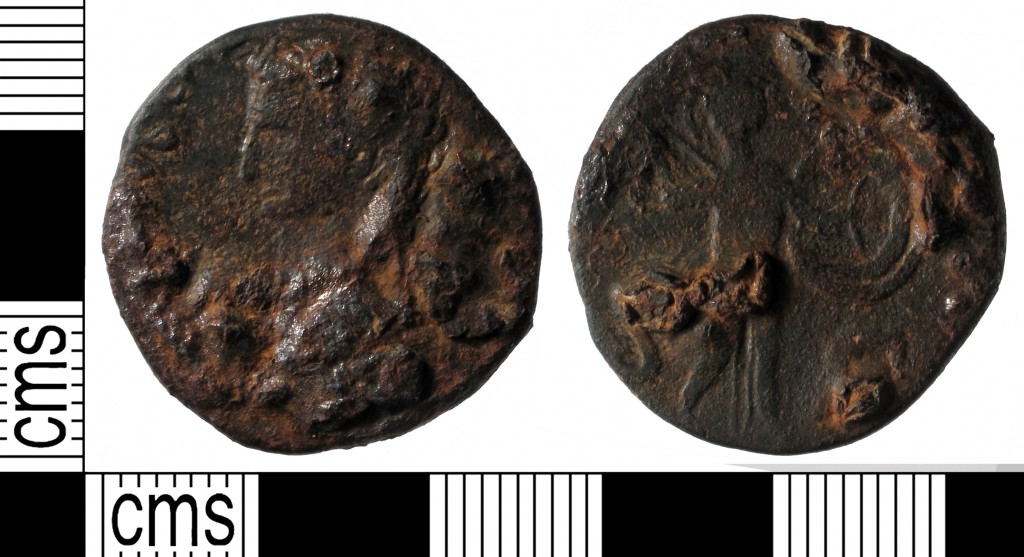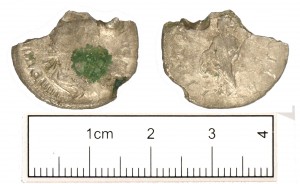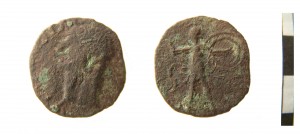I’m afraid (or possibly rather pleased) it has been very busy here with many finds to record so I have not posted for a while. To make up for it here are three interesting finds from the last few weeks to bring to your attention, unusually two of them involve iron which due to its poor of preservation in disturbed contexts such as plough soil is often poorly represented amongst the stray finds we deal with. The vast majority of iron items we see are either modern, where they can be identified usually from farm machinery, or small fragments which are so corroded and fragmentary as to make identification impossible.

SUSS-846943 is a contemporary copy of a Roman coin with an iron core and copper outer surface. If you zoom in closely on the image you can see where the iron core has rusted, expanded and ‘exploded’ through the copper surface. Contemporary copies (as opposed to modern fakes) of Roman coins are not uncommon. Firstly there are the very common copies of radiates and mid-to late 4th century nummi made in something close to the right metal but smaller in size. Secondly there are copper cored silver coins; these are also not rare, it sometimes feels like there are as many contemporary copies of later 2nd century denarii out there as official types. Here are two typical silver plated copper cored coins in different states of preservation, the one on the right shows how the plating is often still in good condiiton and hard to spot.
 ](/findsorgukblogs/files/2010/08/SUSS-E88FF4.jpg)
](/findsorgukblogs/files/2010/08/SUSS-E88FF4.jpg)
Iron cored copies of precious metal coins are know (e.g. SUR-379FD1 and KENT-68D276) but are much rarer than copper cored examples. It could possibly be an accident of preservation with the iron rusting away to nothing but if that was the case you might expect more partially corroded and damaged examples to come to light, after all the gold and silver casings are not negligible in size. This suggests this coin is rare in general in having an iron core as well as being highly unusual as a plated copy of a copper coin.
The coin being copied is an As of Claudius I with Minerva on the reverse. Contemporary copies of these coins are not at all unusual, they are often crude and ‘barbarous’ in style with the left facing long necked head on the obverse and figure advancing right with circular shield flanked by a large ‘S-C’ on the reverse being all that clearly remains of the original design, like this second example. There are many recorded on the database and using the new Roman numismatic search you can quickly pull out all the As of Claudius I for comparison.

Copies of Claudian As are common on early military sites and there is some suggestion that they may in fact have been minted semi-officially by local garrisons who were used to having small change to use for transactions. The argument runs that in the early days after the conquest there was not enough coinage in the country for soldiers everyday needs so they produced their own (see Boon, G. 1988, ‘Counterfeit Coins in Roman Britain’ in Casey & Reese eds., C_oins and the Archaeologist_ London). Civilian populations in some areas, including Sussex, has also got used to low value coins including copper before the conquest and may have felt their lack and produced local alternatives.
In terms of ‘fakes’, excluding modern copies there are three main categories, firstly there are precious metals coins with cores of lower value metals, definitely contemporary copies or fakes designed to deceive, secondly there are smaller and crudely made ‘barbarous copies’ which don’t deceive for an instant and therefore must have been tolerated by the person paid in them, if not, usually, state officials, thirdly there are reasonably made copies in something that looks close to the original metal, these may have operated similarly to the second group or be passed off as genuine coins. While as a cored copy we would usually place this coin in the first category as part of a group with crudely copied designs it perhaps sits more happily in the second group. Interesting BH-40AF20 one of the few other iron cored copper coins I have traced is a barbarous radiate, again part of our second group of copies.
If both the buyer and seller happily use it to settle a transaction knowing it is not an ‘official coin’ we could argue it stops being a ‘fake’ and becomes something else, perhaps the best word for it is ‘token’ (but the long ‘when is a coin not a coin’ discussion is definitely one for another occasion…)